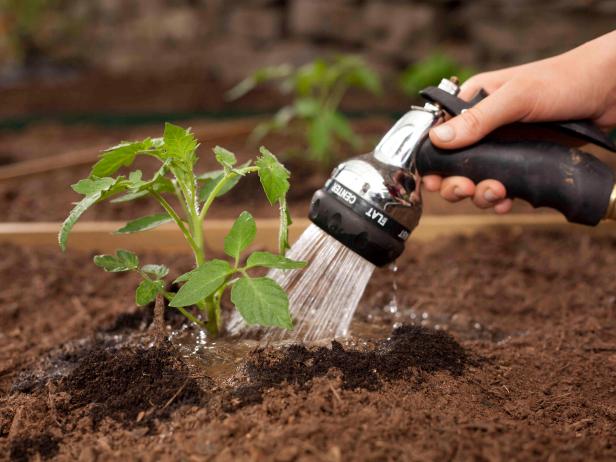 Tomatoes growing in open ground will not survive without regular watering. The lack of moisture that comes during irrigation, tomatoes are difficult to tolerate. The metabolic and physiological processes inside the plant slow down or stop altogether.
Tomatoes growing in open ground will not survive without regular watering. The lack of moisture that comes during irrigation, tomatoes are difficult to tolerate. The metabolic and physiological processes inside the plant slow down or stop altogether.
Lack of sufficient water leads to shedding of ovaries on tomatoes, and excessive waterlogging provokes fungal diseases.
Content
Why watering
Tomatoes consist of 80% water, 94% of the fruits, the remaining 20%, and 6% of the fruits are the dry substances that make up the body of the flora: roots, stems, leaves. Water is necessary in the metabolic processes occurring inside the seedlings.
- Transpiration is the process of movement of water inside a plant, from the roots to all organs, and evaporation of its external parts, mainly leaves. Moving with water, nutrients enter freely in all cells of the plant. The process is also responsible for thermoregulation, protects tomato bushes from overheating and from the destruction of proteins under the influence of heat.
- Chemical reactions are the conversion of nutrients and trace elements into energy and enzymes necessary for the growth and development of tomatoes. Such processes can occur only in aqueous solutions.
- Photosynthesis is a process in which the energy of sunlight is converted into the energy of the chemical bonds of cells of organic substances. Simply put, as a result of photosynthesis reactions, oxygen and glucose molecules necessary for plant life are released from the water.
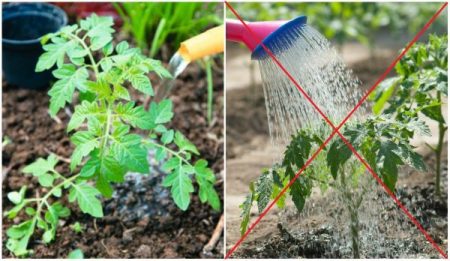
With a lack of moisture, healthy and strong tomato bushes become incapable of life and wither. Weakened plants spend the rest of their vitality exclusively to preserve the roots, and the stems, leaves, fruit ovaries dry up and fall off. Watering restores lost energy and brings tomato bushes back to life.
Tomatoes receive water from the soil after irrigation or during rain. 90-97% of this moisture is spent on metabolic processes. It is necessary to compensate for such losses, which means that the organization of proper watering is indispensable.
Watering time
Tomatoes need to be watered throughout the entire growing season. From sowing seeds to full ripening of fruits, plants need water. An exception to this rule can only be time periods with prolonged heavy rains.
The optimal time of day for watering tomatoes is 1-2 hours before sunset. The surface of the soil before the onset of night coolness should dry out a bit so that the leaves and stems are not supercooled from cold fumes. Watering in the early morning hours, when it is still not very hot, is not excluded. If the sun is at its zenith, then the moist soil surface instantly turns into a dense, hard crust that does not allow air to pass through.
Watering during growth and fruiting
The growing season of tomatoes is divided into several stages:
- Development and growth of seedlings.
- Adaptation to a new place after planting in open ground or in a greenhouse.
- Growth and development before flowering.
- Bloom.
- The formation of fruit ovaries.
- Fruiting.
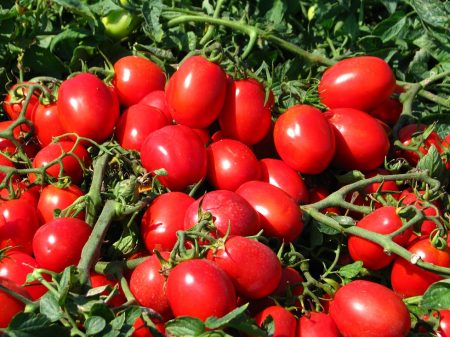
At each stage of growth, tomatoes need watering, but the amount of water and frequency at all stages differ:
- after planting tomato seedlings in open ground and watering them for the first time, you should take a significant break of 10-14 days, let the tomatoes get used to new conditions without disturbing their natural flow;
- watering should be resumed when it becomes noticeable that the plant has taken root and has started to grow, at this time and before flowering, tomatoes are often watered (see the section “Watering Mode” below);
- with the beginning of flowering, watering is less common, but the amount of water is increased;
- during fruit ovary, they increase the volume of water even more at each watering, the frequency is the same as during flowering;
- when the fruits of tomatoes begin to pour, slightly turning brown, the number of irrigations is reduced, the amount of water is reduced, this mode is maintained for the entire period of fruiting.
Regulate the frequency of irrigation and the volume of water is necessary to maintain the water balance of the plant. During active growth, tomatoes absorb significantly more water to build green mass and form stems. Moderate watering during the fruiting period is necessary so that the fruits of the tomatoes do not crack and retain more nutrients.
The taste of tomatoes improves from a high sugar content, the higher its level, the sweeter the fruits. The Cherry tomato variety, for example, is rich in sugars, so tomatoes are very sweet. Reduced watering during the ripening period of tomatoes contributes to the accumulation in the fruits of not only sugar, but also other beneficial substances.
Watering Rules
It is necessary to water tomatoes in the open ground, observing certain rules:
- Tomato seedlings do not tolerate surface watering, the water from the leaves evaporates quickly and does not go to the main source of moisture - to the roots, so it is better to water the bushes under the root.
- After each watering, the soil should be loosened slightly and sprinkled with mulch - a thin layer of peat or dry compost.
- Before irrigation of tomatoes, water from the water supply must be at least 24 hours old to allow the evaporation of harmful impurities.
- When watering, varietal requirements of tomatoes are taken into account. Tall tomato bushes require more water than their low counterparts. Varieties of early ripening should be watered more often, they develop faster, and this requires water.
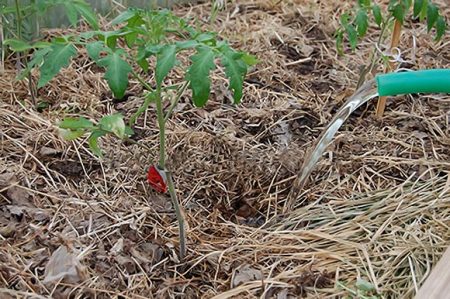
Rules always imply exceptions to them, so gardeners, growing tomatoes in their plots, are guided by real actual conditions: climate, soil composition and fertility, presence or absence of water sources. Different conditions force gardeners to adjust some basic rules.
Natural reservoirs where summer residents take water for irrigation of tomatoes (rivers, ponds and lakes) contain substances that are dangerous for plants: spores of fungi, cells of viral diseases, harmful microorganisms. An additional rule when using such water is its purification. Carry out cleaning in different ways:
- chemical treatment with chlorine preparations;
- use of folk remedies for water purification: iodine, potassium permanganate, soda ash, ash;
- the use of modern cleaning systems.
Rain water is very useful for watering plants, tomato bushes come to life after the rain, are replenished with energy and are ready for further development. The collection of rainwater for irrigation of tomatoes is another additional rule that it is advisable to comply with each rainfall.
Water quality
The temperature of water for irrigation of tomatoes should be in the range from +23 to + 27 ° C. This can be achieved by placing the tank in a sunny place or placing it in a greenhouse. Watering tomatoes with cold water from the water supply is not recommended for the following reasons:
- a sharp drop in temperature will provoke the dropping of fruit ovaries, the suspension of their formation;
- in tap water there are chemical compounds harmful to plants: chlorine, heavy metal molecules.
You can increase the speed of heating the water for irrigation of tomatoes using dark-colored barrels under the tanks.Such painting absorbs the sun's rays well, and the water quickly heats up. The night coolness cools the water, but by the time of irrigation, it will be warm enough and suitable for use during irrigation.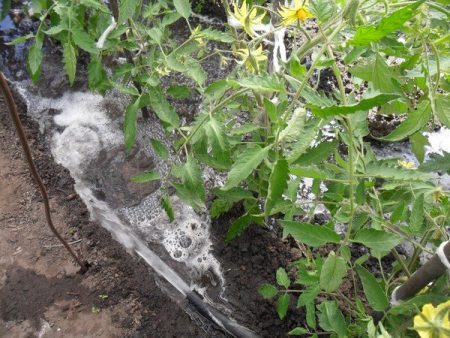
Consumption rates
The amount of water needed to irrigate the tomatoes at different stages of tomato growing is not the same. Gardeners who grow tomatoes for many years find their own optimal options based on the variety, cultivation technology, weather (climatic) conditions. We placed some averaged data in the table of the next section.
Watering mode
It is more difficult to grow tomatoes on open beds than in a greenhouse. The growth of tomatoes here is influenced by many factors related to weather conditions: rain, cold air, through winds or heat. It is necessary to take into account all these nuances when watering tomato bushes.
| Growing season | Period duration | Watering Schedule | The rate of water consumption per 1 bush at each irrigation |
| Active growth | About 2, 5 months from planting seedlings in the ground until flowering | Every 2-3 days | 1-2 liters |
| Bloom | The process does not occur simultaneously (2-3 weeks before the formation of the first fruit ovaries) | Once a week | 5 liters (for tall grades 8-10 liters) |
| Ovary formation | From 2 to 4 weeks (from the moment of formation to the start of ripening) | Once a week | Up to 10 liters |
| Fruiting | Up to 1-1.5 months | 1 time in 10 days (tall tomatoes - every 4 days) | 5 liters, and for tall bushes - 10 liters (2-3 weeks before harvesting, watering is stopped) |
Our recommendations cannot be a panacea for all, especially unforeseen, cases. Real gardeners, using our advice, apply them, taking into account changes in the weather, adjust the number of irrigations and norms of water use based on the specific conditions dictated by the circumstances.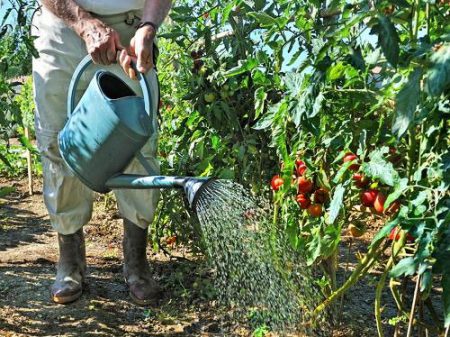
On hot days, when the sun drains the earth quickly and mercilessly, it is necessary to retain moisture in the soil for as long as possible. The use of mulching materials will help in this. As mulch on such days, you can apply: sawdust, straw, dry compost, but in no case peat. Black color absorbs the sun's rays and heats the soil surface at the roots of tomatoes even more.
Drip irrigation
The introduction of modern technologies in crop production has significantly reduced labor costs and resource consumption. One of these inventions was the use of drip irrigation systems. Land owners have successfully used such an irrigation system to irrigate horticultural crops, flower beds and lawns.
Automated drip irrigation systems, arranged in gardens and greenhouses, save time, water, reduce the complexity of work. Skillful gardeners install their own systems on the beds themselves. These systems may be far from perfect, but they also do their job well.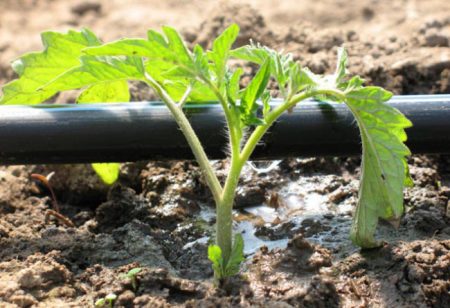
Drip irrigation of tomatoes is a method of irrigating a plant, in which water falls only under the root of the tomatoes and moistens the soil at the base of the main stem. With this method, you can adjust the amount of water and the intensity of irrigation, it fully meets the agrotechnical requirements of tomatoes during irrigation.
You can also use the system for feeding tomatoes by adding the necessary fertilizers to the tanks. They get directly to the roots of tomatoes and are not wasted in vapors when evaporation of moisture from leaves and soil surface.
Conclusion
The quantity and quality of irrigation when growing tomatoes in the open field are important aspects that should not be forgotten. Plants, like people, cannot live and develop without water. The yield and taste of the fruit to a large extent depend on how much, when, and in what quantity the seedlings receive the necessary moisture. Your tomato bushes, regardless of variety and time of fruit ripening, will always be responsive to care and care.




 Low-growing tomatoes, without pinching: 5 of the most delicious varieties
Low-growing tomatoes, without pinching: 5 of the most delicious varieties Why tomato seedlings grow poorly
Why tomato seedlings grow poorly We grow a tomato in a shell
We grow a tomato in a shell Growing tomatoes without watering according to the method of Kazarin
Growing tomatoes without watering according to the method of Kazarin